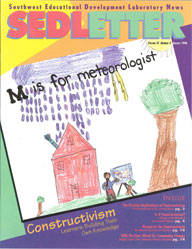The Practice Implications of Constructivism
Constructivism has roots in philosophy, psychology, sociology, and education. But while it is important for educators to understand constructivism, it is equally important to understand the implications this view of learning has for teaching and teacher professional development.
Constructivism's central idea is that human learning is constructed, that learners build new knowledge upon the foundation of previous learning. This view of learning sharply contrasts with one in which learning is the passive transmission of information from one individual to another, a view in which reception, not construction, is key.
Two important notions orbit around the simple idea of constructed knowledge. The first is that learners construct new understandings using what they already know. There is no tabula rasa on which new knowledge is etched. Rather, learners come to learning situations with knowledge gained from previous experience, and that prior knowledge influences what new or modified knowledge they will construct from new learning experiences.
The second notion is that learning is active rather than passive. Learners confront their understanding in light of what they encounter in the new learning situation. If what learners encounter is inconsistent with their current understanding, their understanding can change to accommodate new experience. Learners remain active throughout this process: they apply current understandings, note relevant elements in new learning experiences, judge the consistency of prior and emerging knowledge, and based on that judgment, they can modify knowledge.
Constructivism has important implications for teaching. First, teaching cannot be viewed as the transmission of knowledge from enlightened to unenlightened; constructivist teachers do not take the role of the "sage on the stage." Rather, teachers act as "guides on the side" who provide students with opportunities to test the adequacy of their current understandings.
Second, if learning is based on prior knowledge, then teachers must note that knowledge and provide learning environments that exploit inconsistencies between learners' current understandings and the new experiences before them. This challenges teachers, for they cannot assume that all children understand something in the same way. Further, children may need different experiences to advance to different levels of understanding.
Third, if students must apply their current understandings in new situations in order to build new knowledge, then teachers must engage students in learning, bringing students' current understandings to the forefront. Teachers can ensure that learning experiences incorporate problems that are important to students, not those that are primarily important to teachers and the educational system. Teachers can also encourage group interaction, where the interplay among participants helps individual students become explicit about their own understanding by comparing it to that of their peers.
Fourth, if new knowledge is actively built, then time is needed to build it. Ample time facilitates student reflection about new experiences, how those experiences line up against current understandings, and how a different understanding might provide students with an improved (not "correct") view of the world.
If learning is a constructive process, and instruction must be designed to provide opportunities for such construction, then what professional development practices can bring teachers to teach in student-centered ways?
First recognize that construction in learning is not just the domain of children but of learners, all learners. Constructivist professional development give teachers time to make explicit their understandings of learning (e.g., is it a constructive process?), of teaching (e.g., is a teacher an orator or a facilitator, and what is the teacher's understanding of content?), and of professional development (e.g., is a teacher's own learning best approached through a constructivist orientation?). Furthermore, such professional development provides opportunities for teachers to test their understandings and build new ones. Training that affects student-centered teaching cannot come in one-day workshops. Systematic, long-term development that allows practice - and reflection on that practice - is required.
It is also useful to remember the educator's maxim, Teachers teach as they are taught, not as they are told to teach. Thus, trainers in constructivist professional development sessions model learning activities that teachers can apply in their own classrooms. It is not enough for trainers to describe new ways of teaching and expect teachers to translate from talk to action; it is more effective to engage teachers in activities that will lead to new actions in classrooms.
Constructivism represents one of the big ideas in education. Its implications for how teachers teach and learn to teach are enormous. If our efforts in reforming education for all students are to succeed, then we must focus on students. To date, a focus on student-centered learning may well be the most important contribution of constructivism.
Wes Hoover is SEDL president and CEO. He holds a doctorate from The University of Texas at Austin in human experimental psychology, with a specialization in reading and psycholinguistics.
Next Article: Is It Constructivism?

